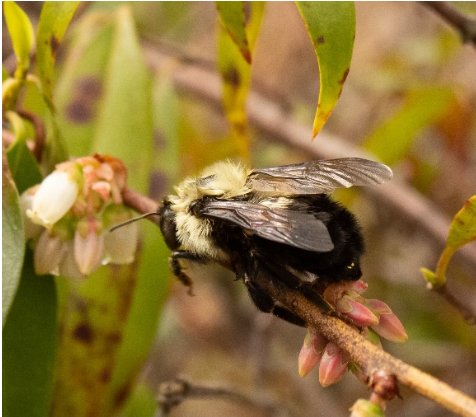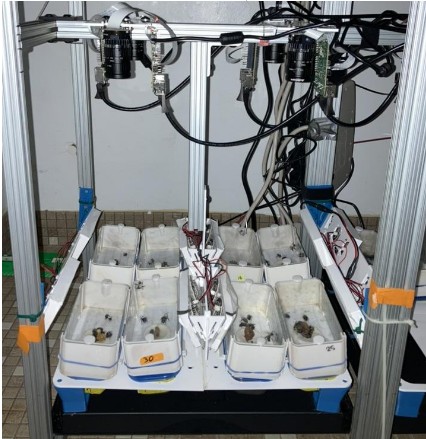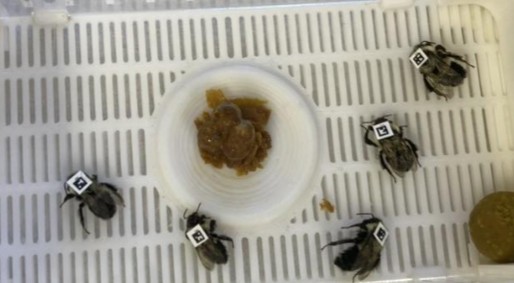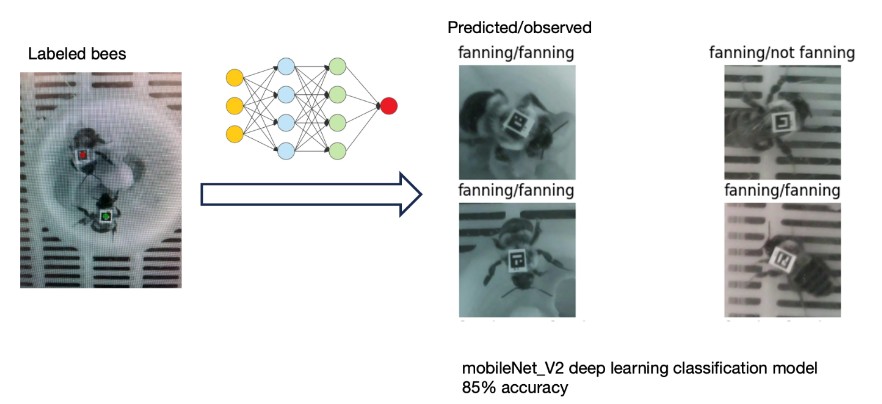
Through their important role as pollinators, bees support the survival and sustenance of entire ecosystems, impacting diverse plant and animal species worldwide, including humans. Bees are critical for agriculture, as pollination by bees supports both the quality and productivity of crop yields. Thus, bees are a bridge that reminds us of our integration with, and dependence on, the natural world. Bees also remind us of our effects on the natural world through the various human-driven changes that impact them. Declines in bee populations have been attributed to habitat loss, habitat fragmentation, pesticide use, and of course, climate change. Heat stress is particularly dangerous for bumblebees, which are adapted to cooler climates. The complex challenges that drive declines in bee populations are also pushing researchers to develop novel approaches to study bees. To conserve bees and repair the ecological bridges that they represent, researchers conduct assessments of bee morphology, behavior, physiology, ecology, and evolution. Grace Melone, a PhD student in the Department of Integrative Biology at the University of Wisconsin Madison, is one such researcher working to care for our ecological bridges by studying insect thermal biology, plant-insect interactions, and disturbance ecology.
Melone grew up in Seattle, Washington, where she noticed an abundance of bumblebees busily flying around her family’s garden. Bumblebees are adapted to temperate regions and have specialized traits that allow them to thrive in cool regions like Seattle. Bumblebees can generate heat to warm their body for flight, and long insulatory hairs, called setae, allow them to retain that heat. Bees also have specialized reproductive traits that are useful in the cold, such as the ability to hatch new workers rapidly by maintaining a tightly controlled nest temperature. During incubation, bumblebees curl over the brood and shunt blood (and therefore heat) to the abdomen to warm the eggs to between 30 and 32°C (86 and 89.6°F), the optimal incubation temperature.
As Melone grew older, she began to notice fewer and fewer bees in her family’s garden, and she began to wonder if rising temperatures might have something to do with the decline she noticed in her own backyard. As a Seattle native, Melone was shocked by a 70°F day in February that she experienced upon moving to Davis, California, for her undergraduate studies. These experiences fed her curiosity, and after seeing a lack of readily available information on the subject, she began seeking her own answers through research. Melone studied the effects of heatwaves on bees through research on larval development by exposing early-stage mason bees to simulated heatwaves of different temperatures. Melone learned that bees experience lower survival and longer development times at higher temperatures, which bees may experience more often due to the increasing intensity and frequency of heatwaves. Her work, and work from other groups, indicate that bumblebee larvae and pupae fare poorly above 35°C, especially in earlier larval stages.

Now as a PhD student at the University of Wisconsin Madison, Melone studies how bees can avoid the negative impacts of heat. Specifically, she studies the behavioral adaptations of adult bumblebees and the resulting outcomes for adults and larvae. When temperature rises, bumblebees attempt to cool the nest by fanning their wings rapidly to increase air flow over the nest; Melone describes this behavior as looking like “flying without leaving the ground”. However, Melone’s recent findings suggest that bumblebees are not able to effectively cool the nest through fanning. Because bumblebees can nest above ground, ambient temperature can quickly influence the internal nest temperature.
As Melone continues to work on developing her research, she finds that there is more work left to do. With bees and other insects, high biodiversity also leads to a diversity of thermoregulatory strategies, which can be difficult to study comprehensively due to the variety of unique life stages. Because there is a tendency to focus on the life stages we can easily see, adults are studied more, leading to gaps in knowledge regarding younger life stages. Furthermore, it is difficult to rear larvae in lab settings, and collecting data on individual larvae can also prove challenging. To effectively research these nuanced changes within a single species would require considerable logistical effort. But despite her growing realization of the challenge at hand, this is an area where Melone feels hope.

Melone envisions a better understanding of behavior catalyzed by the growing application of artificial intelligence (AI) for research in the near future. For her research, Melone applies cutting edge technology in the form of computer vision and deep learning classification models to automatically identify bees and their behaviors from video. Melone attaches a tag with a QR code to each bee, which allows the model to identify the individual, track it as it moves through the frame, and identify its behaviors. With this novel tool, Melone leverages AI to process thousands of hours of video data on fanning behavior, which would otherwise take years to process. This allows Melone to test specific hypotheses by analyzing the use of individual behaviors and interindividual variation in these behaviors during simulated heatwaves.

In addition to simulated heatwaves, Melone is investigating how nutrition influences brood thermoregulation by testing the effect of nutritional quality. In the lab, Melone simulates a heatwave while adults are incubating their brood, and she splits the adults into two groups: one that is provided with high quality (50% sucrose) nectar, and another with low quality (25% sucrose) nectar. Melone expected the higher quality nutrition group to maintain fanning behavior longer during the simulated heatwaves, leading to greater adult and brood survival in the high-quality nutrition group. Lower colony performance, in the form of fewer surviving brood and fewer surviving workers, was observed in the lower nutrition group. However, interestingly, there was no difference in fanning behavior between the two groups, despite greater energy costs associated with fanning behavior. This suggests that bumblebees may use other behaviors to thermoregulate and that there are other behaviors to be observed, which is a future direction for this research.
In addition to the rapid progress that can be made in studying behaviors using AI, Melone sees other important areas where AI can help us make progress. In Melone’s own words, “ There’s a sentiment in field ecology that it has to be difficult to be worthwhile – and I just don’t think that’s true. As we’re able to integrate new technology, like computer vision techniques, we’ll be able to get more and better data, and do so in environments that were previously inaccessible. By reducing the need for dangerous practices, novel technologies can make data collection safer, and therefore more accessible. I think we can envision a better future and field ecology that works for more people.”
Author Bio:
Juan Zuluaga is a postdoctoral researcher at the University of Tennessee Knoxville working with Dr. Elizabeth Derryberry. Juan’s research focuses on studying thermoregulation using integrative approaches that blend behavioral and physiological approaches. His current work involves studying phenotypic plasticity in thermoregulatory traits in zebra finches. When he is not in the lab, he enjoys cycling and being outdoors with his family.

